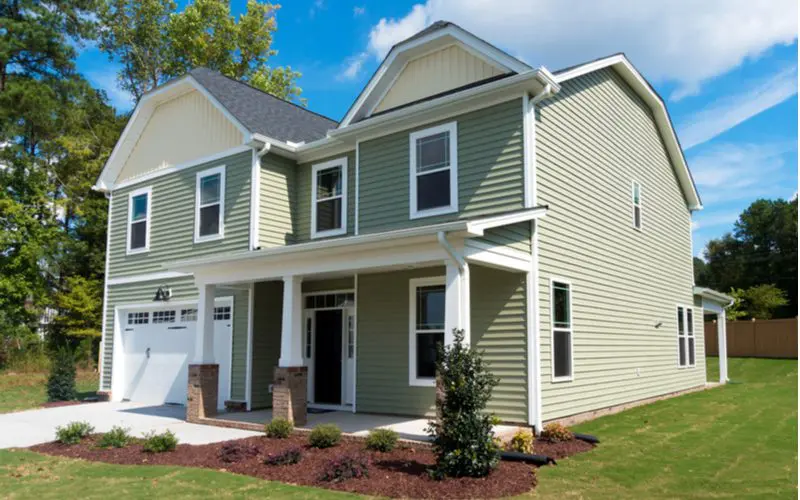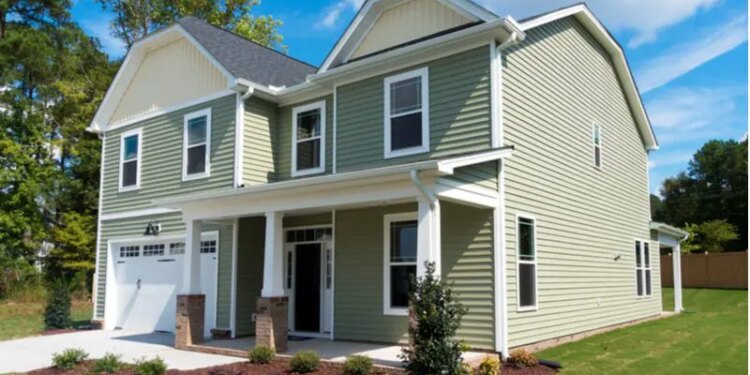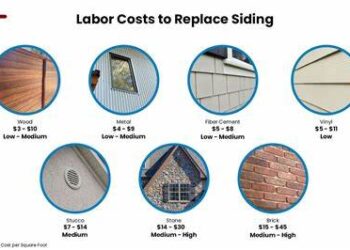Delving into the realm of whole house siding cost, this article uncovers the key aspects that influence pricing, the various materials available, and smart strategies to save money. Get ready for an informative journey that will help you make informed decisions for your home.

Factors Affecting Whole House Siding Cost
When considering the cost of siding a whole house, there are several key factors that can influence the overall price. Factors such as material choice, labor costs, house size, and geographical location all play a significant role in determining the total cost.
Material Choice
The material you choose for your siding can have a major impact on the overall cost. Certain materials, like vinyl or aluminum, tend to be more affordable options compared to premium materials like wood or fiber cement. The quality, durability, and maintenance requirements of the chosen material will also affect the cost in the long run.
Labor Costs
Labor costs are another important factor to consider when calculating the total cost of siding a whole house. The complexity of the installation, the experience of the contractors, and the location of your property can all influence labor costs. Hiring reputable professionals may come at a higher price, but it can ensure a quality installation that will last for years to come.
House Size
The size of your house will directly impact the amount of material needed for siding, which in turn affects the overall cost. Larger homes require more materials and more labor to complete the installation, resulting in a higher total cost compared to smaller homes.
It's essential to accurately measure the square footage of your property to get an accurate estimate of the cost.
Geographical Location
Geographical location can also play a role in determining the cost of siding a whole house. Prices for materials and labor can vary significantly depending on where you are located. For example, areas with high demand for siding services or higher cost of living may have higher overall costs.
It's essential to consider the local market conditions when budgeting for your siding project.
Types of Siding Materials and Their Costs
When it comes to choosing siding materials for your home, there are several options available that vary in cost, durability, and maintenance requirements. Understanding the different types of siding materials and their associated costs can help you make an informed decision that fits your budget and needs.Vinyl Siding:Vinyl siding is one of the most popular choices due to its affordability and low maintenance requirements.
The cost of vinyl siding typically ranges from $2 to $7 per square foot, making it a budget-friendly option for many homeowners. While vinyl siding is durable and comes in a variety of colors and styles, it may not offer the same level of insulation as other materials.Wood Siding:Wood siding is known for its natural beauty and timeless appeal, but it comes at a higher cost compared to vinyl.
The cost of wood siding can range from $5 to $10 per square foot, depending on the type of wood used. While wood siding requires more maintenance to prevent rot and decay, it can add a charming aesthetic to your home.Fiber Cement Siding:Fiber cement siding is a versatile option that combines the durability of cement with the look of wood.
The cost of fiber cement siding typically falls between $5 to $12 per square foot. While fiber cement siding is resistant to rot, fire, and pests, it may require professional installation due to its weight.Metal Siding:Metal siding, such as aluminum or steel, offers a modern and sleek appearance with minimal maintenance required.
The cost of metal siding can range from $5 to $15 per square foot, depending on the type of metal used. While metal siding is durable and can last for decades, it may dent or scratch easily.Each siding material has its own set of pros and cons in terms of cost-effectiveness, durability, and maintenance requirements.
Consider your budget, aesthetic preferences, and long-term goals when choosing the right siding material for your home.
Calculating Total Cost
When it comes to siding a whole house, it is essential to consider the total cost involved. This includes labor costs, material costs, permits, and any additional expenses that may arise during the process.
Labor Costs
Labor costs can vary depending on the region, the experience of the contractors, and the size of the house. It is crucial to get multiple quotes from different contractors to ensure you are getting a fair price for the labor involved.
Material Costs
The cost of siding materials will depend on the type of material you choose, such as vinyl, wood, fiber cement, or metal. Each material has its own price point, so it is essential to consider both the initial cost and the long-term maintenance requirements when making your selection.
Permits and Additional Expenses
Obtaining permits for siding work may incur additional costs, depending on your local regulations. Other expenses to consider include disposal fees for old siding, equipment rentals, and any unexpected repairs that may be needed once the old siding is removed.
Estimating Siding Amount
To estimate the amount of siding needed for your whole house, you can calculate the square footage of each wall and subtract the square footage of windows and doors. This will give you a rough estimate of how much siding material you will need based on your house size and the type of material chosen.
Ways to Save on Whole House Siding Costs
When it comes to siding your entire house, there are several ways you can save on costs without compromising on quality. From considering DIY options to negotiating prices with contractors, here are some strategies to help you reduce the overall expense.
Consider DIY Options
If you have some experience with home improvement projects, taking on the siding installation yourself can lead to significant cost savings. By eliminating labor costs, you can allocate more of your budget towards high-quality siding materials. However, it's essential to weigh the pros and cons and ensure you have the necessary skills and tools for the job.
Negotiate Prices with Contractors and Suppliers
Don't be afraid to negotiate prices with contractors and suppliers to get the best deal possible. Obtain multiple quotes and compare them to leverage price competition. You can also ask for discounts or explore different payment options to lower the overall cost.
Building a good relationship with the professionals you're working with can also lead to potential savings.
Ending Remarks
In conclusion, understanding the factors affecting whole house siding cost, exploring different materials and their costs, calculating total expenses, and learning ways to save can empower you as a homeowner. Make wise choices and enjoy a beautiful, cost-effective siding for your entire house.
Popular Questions
How do geographical locations affect whole house siding cost?
Geographical locations can impact costs due to varying labor rates, material availability, and local regulations.
Is DIY siding installation a cost-effective option?
DIY siding installation can save money on labor costs but may require specialized tools and skills to ensure proper installation.
What are some additional expenses to consider when budgeting for whole house siding?
Additional expenses may include permits, disposal fees for old materials, and any unexpected repairs or modifications needed during installation.















